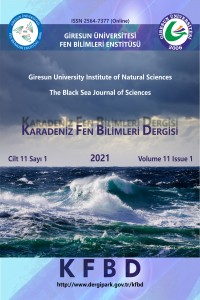Büyükbaş Hayvan Atıkları ile Meyve Sebze Atıklarının Kompostlaştırılması Üzerine Nem İçeriğinin Etkisi
Abstract
Keywords
Hayvan atıkları Büyükbaş hayvan atığı Kompostlaştırma Birlikte Kompostlaştırma Meyve sebze atıkları
References
- Bernal, M.P., Alburquerque, J.A., Moral, R., 2009. Composting of animal manures and chemical criteria for compost maturity assessment. Rev. Bioresour. Technol. 100 (22), 5444-5453.
- ÇSB, 2020. Hayvansal Atık Yönetimi. Retrieved from https://bartin.csb.gov.tr/hayvansal-atik-yonetimi-haber-64223
- DPT, 2001. Hayvancılık Özel İhtisas Komisyonu Raporu, Sekizinci Beş Yıllık Kalkınma Planı, 2001.
- Epstein, E., 2011. Industrial Composting: Environmental Engineering and Facilities Management, CRC Tailor & Francis Group Press, Boca Raton.
- FCQAO, 1994. Methods Book for Analysis of Compost, Federal Compost Quality Assurance Organisation, Stuttgart, Germany.
- Haug, R.T., 1993. The Practical Handbook of Compost Engineering, Lewis Publishers, Boca Raton.
- Hepperly, P., Lotter, D., Ulsh, C.Z., Reider, C., 2009. Compost, manure and syntheticfertilizer influences crop yields, soil properties, nitrate leaching and crop nutri-ent content. Compost Science & Utilization, 17, 117-126.
- KB, 2018. Tarım ve Gıdada Rekabetçi Üretim, Özel İhtisas Komisyonu Raporu, Kalkınma Bakanlığı, Ankara.
- Materechera, S.A., Salagae, A.M., 2002. Use of partial decomposed cattle and chickenamended with wood-ash in two South African arable soils with contrasting tex-ture: effect on nutrient uptake, early growth and dry matter yield of maize. Communications Soil Science and Plant Analysis, 33, 179–201.
- Nyamangara, J., Gotosa, J., Mpofu, S.E., 2001. Cattle manure effect on structural sta-bility and water relation capacity of granitic soil in Zimbabwe. Soil Tillage Research, 62,157-162.
- Öztürk, M. Hayvan Gübresinden Ve Atıklardan Kompost Üretimi
- Öztürk, M., 2017. Hayvan Gübresinden ve Atıklardan Kompost Üretimi, Çevre ve Şehircilik Bakanlığı, Ankara.
- Sims, J.T., Maguire, R.O., 2005. Manure Management, Encyclopedia of Soils in the Environment, Ed. D. Hillel, Elsevier Ltd, 402-410.
- TUİK, 2020. Hayvansal Üretim İstatistikleri, Retrieved from https://data.tuik.gov.tr/Bulten/Index?p=Hayvansal-Uretim-Istatistikleri-Aralik-2020-37207,
Abstract
References
- Bernal, M.P., Alburquerque, J.A., Moral, R., 2009. Composting of animal manures and chemical criteria for compost maturity assessment. Rev. Bioresour. Technol. 100 (22), 5444-5453.
- ÇSB, 2020. Hayvansal Atık Yönetimi. Retrieved from https://bartin.csb.gov.tr/hayvansal-atik-yonetimi-haber-64223
- DPT, 2001. Hayvancılık Özel İhtisas Komisyonu Raporu, Sekizinci Beş Yıllık Kalkınma Planı, 2001.
- Epstein, E., 2011. Industrial Composting: Environmental Engineering and Facilities Management, CRC Tailor & Francis Group Press, Boca Raton.
- FCQAO, 1994. Methods Book for Analysis of Compost, Federal Compost Quality Assurance Organisation, Stuttgart, Germany.
- Haug, R.T., 1993. The Practical Handbook of Compost Engineering, Lewis Publishers, Boca Raton.
- Hepperly, P., Lotter, D., Ulsh, C.Z., Reider, C., 2009. Compost, manure and syntheticfertilizer influences crop yields, soil properties, nitrate leaching and crop nutri-ent content. Compost Science & Utilization, 17, 117-126.
- KB, 2018. Tarım ve Gıdada Rekabetçi Üretim, Özel İhtisas Komisyonu Raporu, Kalkınma Bakanlığı, Ankara.
- Materechera, S.A., Salagae, A.M., 2002. Use of partial decomposed cattle and chickenamended with wood-ash in two South African arable soils with contrasting tex-ture: effect on nutrient uptake, early growth and dry matter yield of maize. Communications Soil Science and Plant Analysis, 33, 179–201.
- Nyamangara, J., Gotosa, J., Mpofu, S.E., 2001. Cattle manure effect on structural sta-bility and water relation capacity of granitic soil in Zimbabwe. Soil Tillage Research, 62,157-162.
- Öztürk, M. Hayvan Gübresinden Ve Atıklardan Kompost Üretimi
- Öztürk, M., 2017. Hayvan Gübresinden ve Atıklardan Kompost Üretimi, Çevre ve Şehircilik Bakanlığı, Ankara.
- Sims, J.T., Maguire, R.O., 2005. Manure Management, Encyclopedia of Soils in the Environment, Ed. D. Hillel, Elsevier Ltd, 402-410.
- TUİK, 2020. Hayvansal Üretim İstatistikleri, Retrieved from https://data.tuik.gov.tr/Bulten/Index?p=Hayvansal-Uretim-Istatistikleri-Aralik-2020-37207,
Details
| Primary Language | Turkish |
|---|---|
| Subjects | Engineering |
| Journal Section | Articles |
| Authors | |
| Publication Date | June 15, 2021 |
| Published in Issue | Year 2021 Volume: 11 Issue: 1 |
 This work is licensed under a Creative Commons Attribution-NonCommercial-ShareAlike 4.0 International License.
This work is licensed under a Creative Commons Attribution-NonCommercial-ShareAlike 4.0 International License.


